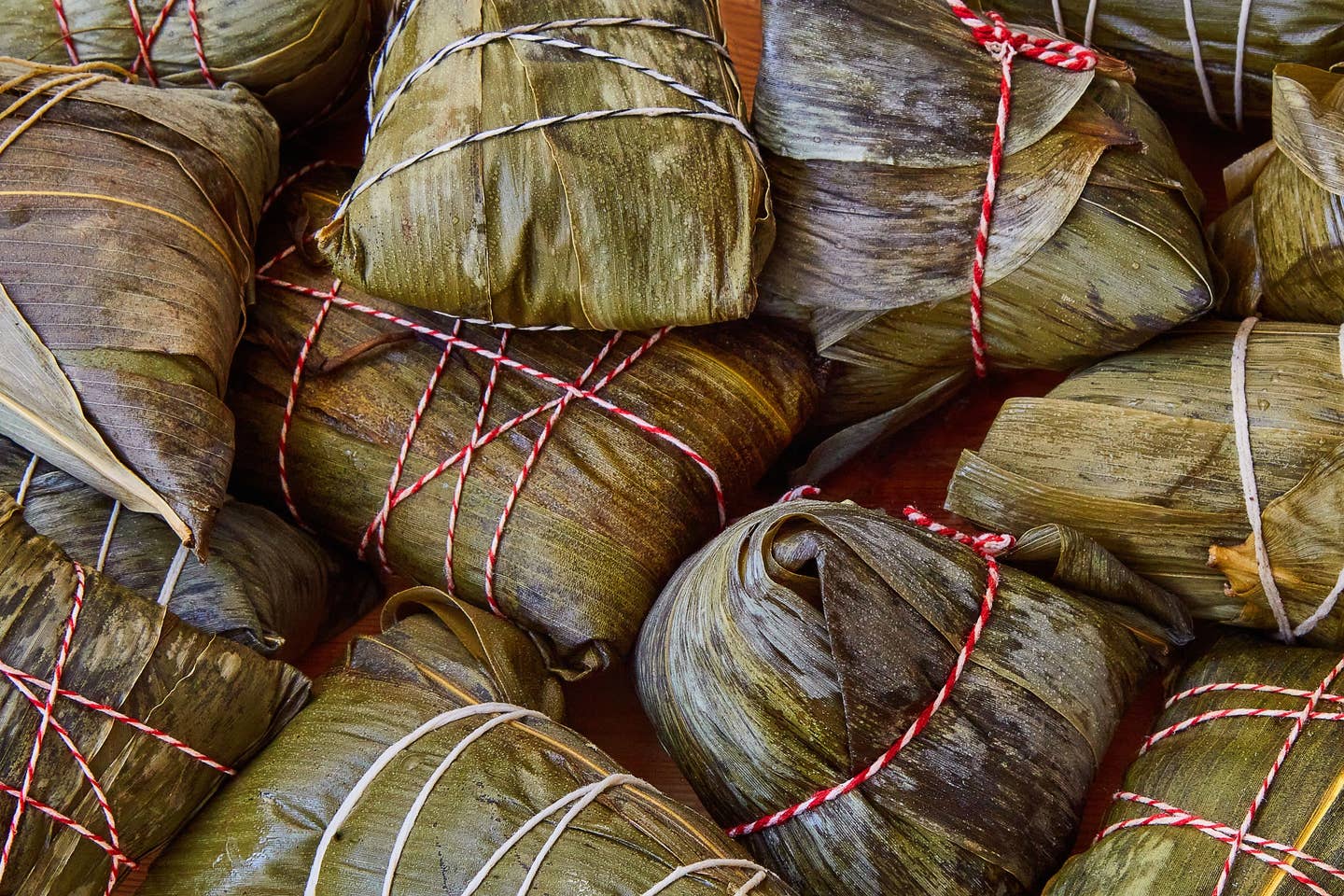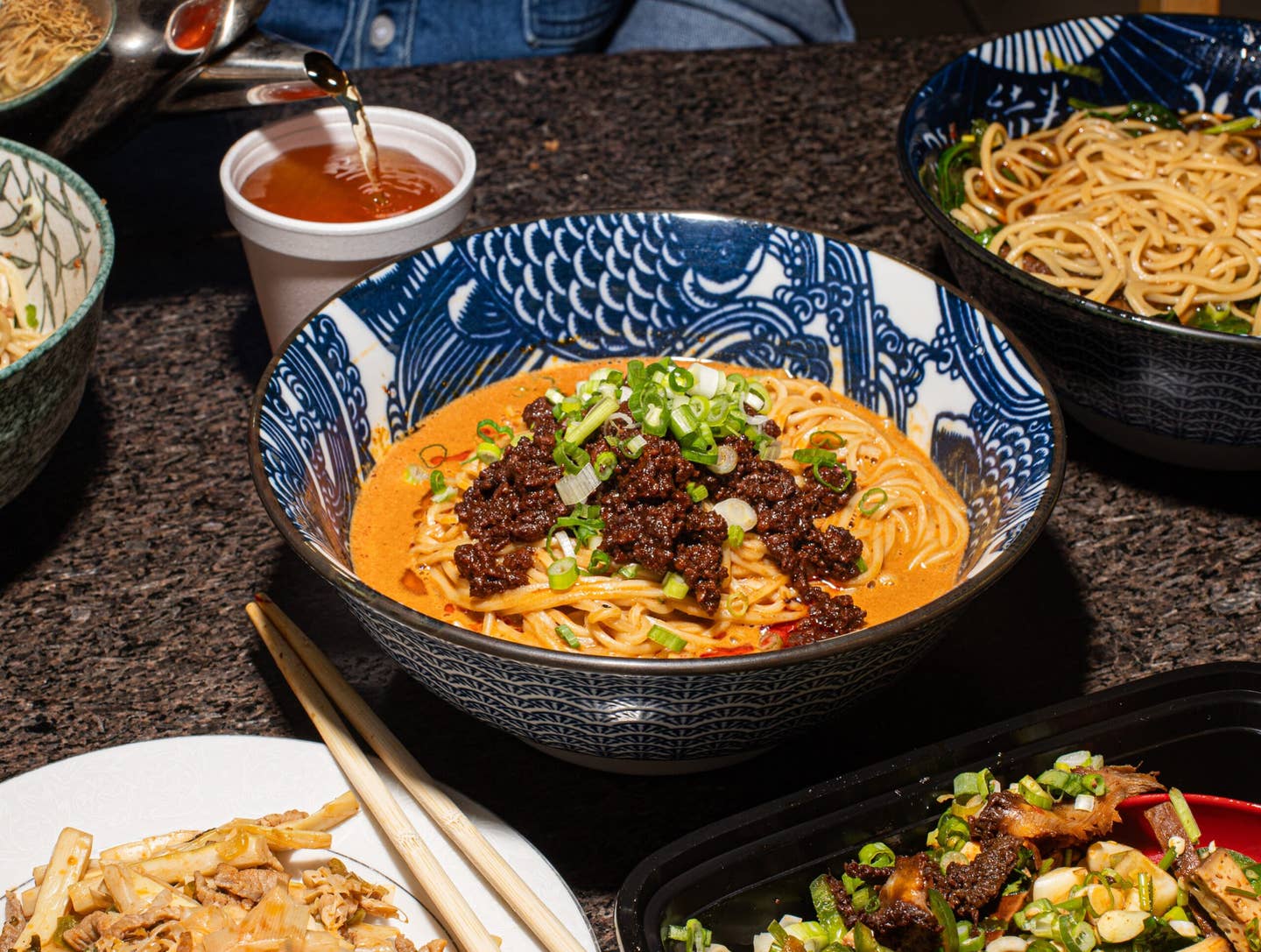
Dragon Boat Festival Is the Perfect Excuse to Indulge in Every Kind of Sticky Rice
From blue-hued Malaysian-style to a sweet Northern Chinese variety, here’s where to eat the traditional snack around Manhattan—or recreate it at home.
For as long as I can remember, I’ve heard the same story every year during the Dragon Boat Festival. The lasting tale has been passed down over centuries, each generation telling it to the next. Some years, a teacher at the Chinese language school I attended every Sunday afternoon would pass around a printout recounting the ancient allegory. Other years, my dad would tell me the tale at the breakfast table—before we all dug into a plate piled high with sticky rice wrapped in bamboo leaves.
The observance of the Dragon Boat Festival, held annually on the fifth day of the fifth lunar month, is inseparable from this dish, which I grew up calling zongzi. Depending where you are in the world, it goes by different names (including joong and bak zhang) and can be sweet or savory, made with different techniques and encased with diverse fillings.
As with many holidays, exact details of the festival’s origins are hazy, with differing narratives colliding and coalescing over time. The most enduring explanation of why we observe the holiday is that the festival commemorates the poet Qu Yuan, who served as an advisor in the court of Chu during China’s Warring States period (475 - 221 BCE). When he warned the emperor about the looming threat posed by the state of Qin, others in the court disagreed and slandered him; the emperor, perceiving disloyalty, exiled Qu Yuan. The advisor’s instincts, however, had been right; the Chu capital was captured, and a heartbroken Qu Yuan drowned himself in the river. Local villagers paddled out onto the water in boats to search for his body while beating drums and splashing the water to fend off fish and evil spirits. The villagers tossed packets of rice into the river, to feed the fish and keep them away from Qu Yuan's corpse. According to folklore, these events birthed Dragon Boat Festival traditions that carry on to this day.
Despite the holiday’s somber origins, the time-honored custom of making and eating zongzi has evolved into a cherished (and year-round) affair. Preparing them is a labor of love, usually a multi-day process that involves soaking the leaves overnight, marinating the fillings for hours, and painstakingly wrapping and tying each package with twine. (My colleague Kat Craddock learned how to make them from Mei Zeng, her Chinese American friend’s mother and a talented home cook who lives in Brooklyn.) I’ve witnessed or participated in the complex process many times, as one of the most renowned places in China to enjoy zongzi is my mom's hometown: Jiaxing, a city in Eastern China’s Zhejiang province. Wufangzhai, arguably the most famous zongzi brand in the country, originated there, so if you mention Jiaxing to anyone in China, there's a good chance they'll exclaim something about zongzi, even if they have never visited the city in person. Whenever my family reunites with our relatives in Jiaxing, the dish is nearly always our very first breakfast—and one of my favorite things in the world to eat.
Though I have a soft spot for the version from my ancestral hometown, one of the best things about sticky rice wrapped in bamboo leaves is the range of cooking techniques, fillings, and shapes found across China and other Asian countries, with different regions popularizing their own renditions of the snack. A unifying theme—besides being scrumptious—is that many types are strongly associated with the Dragon Boat Festival. Here are a few varieties to enjoy this year, and some spots where you can get them in New York City.
Savory Cantonese
Cantonese-style sticky rice parcels often feature savory ingredients like peanuts, salted egg yolks, Chinese sausages, pork, and mung bean, the last of which provides a creamy contrast to the gooey rice. Like with much Cantonese cooking, seasonings are relatively light, leaving room for the inherent flavors of the individual ingredients to shine. Even “the leaf releases its own fragrance,” says Sarah Leung, who writes the Chinese food blog The Woks of Life with her family. With so many different ingredients wrapped up in each individual package, no two bites are the same. Look for this variety of sticky rice at Mee Sum Cafe or Ho Won Bake in Manhattan’s Chinatown.
Alkaline Cantonese
Also emblematic of Southern China’s Cantonese cuisine is this sweet style that requires soaking the glutinous rice in lye water, an alkaline liquid that includes potassium carbonate. This step makes the rice softer and stickier and causes the kernels to take on an amber hue as they cook. “Using the alkaline will release the color from the leaves, so it kind of dyes the rice into that yellow color,” says Maggie Zhu, who created the Chinese food blog Omnivore’s Cookbook. The rice is often filled with red bean paste, and served with honey or sugar for added sweetness. Try this variety at Mee Sum Cafe or Ho Won Bake.
Northern Chinese
It isn’t only Southern China that makes sticky rice with a bit of sugar. Sweet varieties dominate in Northern China, where the rice doesn’t call for any lye water and is thus chewier and firmer in texture. According to Zhu, who grew up in Beijing, red bean zongzi are popular there, though it’s also common to mix the whole beans directly into the rice. Try sweet red bean zongzi at Mee Sum Cafe (where it’s labeled Shanghai-style—red bean is also beloved in the eastern Chinese city), or pay a visit to the Zongzi Lady who has sold different varieties of leaf-wrapped sticky rice outside New York City’s Grand Street subway station for over a decade. Zhu’s family also likes to add dried fruit into sweet mixtures: “My grandma and my mom, they usually make one with jujubes,” which steam alongside the rice and release their fragrance as the packets cook.
Malaysian
When you unwrap sticky rice from bamboo leaves in Malaysia, where the dish is called bak zhang, you’ll often notice one corner of the rice has been dyed blue, courtesy of bunga telang, a butterfly pea flower. “It’s supposed to bring good luck and ward off evil,” says Christina Arokiasamy, a chef who hails from Malaysia. Galangal, coriander seeds, and white peppercorn give the sticky rice an herbaceous aroma. The dish also offers a nice balance of sweet and savory, thanks to candied winter melon and pork belly. Find it at Kopitiam in Manhattan’s Lower East Side.
Shanghainese
In savory Shanghai-style zongzi, pork is the star of the show. For contrast and balance, these parcels often include both fatty and lean chunks of meat. As the packages boil and cook, the fat melts, depositing flavor into every kernel. The resulting taste is luscious and rich, yet doesn’t taste heavy. Before wrapping, cooks coat the rice and fillings in soy sauce, which imparts lovely umami. Have a taste for yourself at Chinatown’s Supreme Restaurant.
Taiwanese
Annie Wang, a Taiwanese American food writer who blogs at Frites & Fries, grew up eating a rendition of sticky rice emblematic of Taiwan. “For my family, both my mom and dad’s sides, we’re very pro-savory,” she says. Given the island’s robust shrimping industry, Wang explains, it’s no surprise that zongzi from the southwest city of Tainan often include dried shrimp, as well as shiitake mushrooms, dried scallops, peanuts, and pork. Sample a homemade version from the Zongzi Lady herself.
Keep Reading
Continue to Next Story










